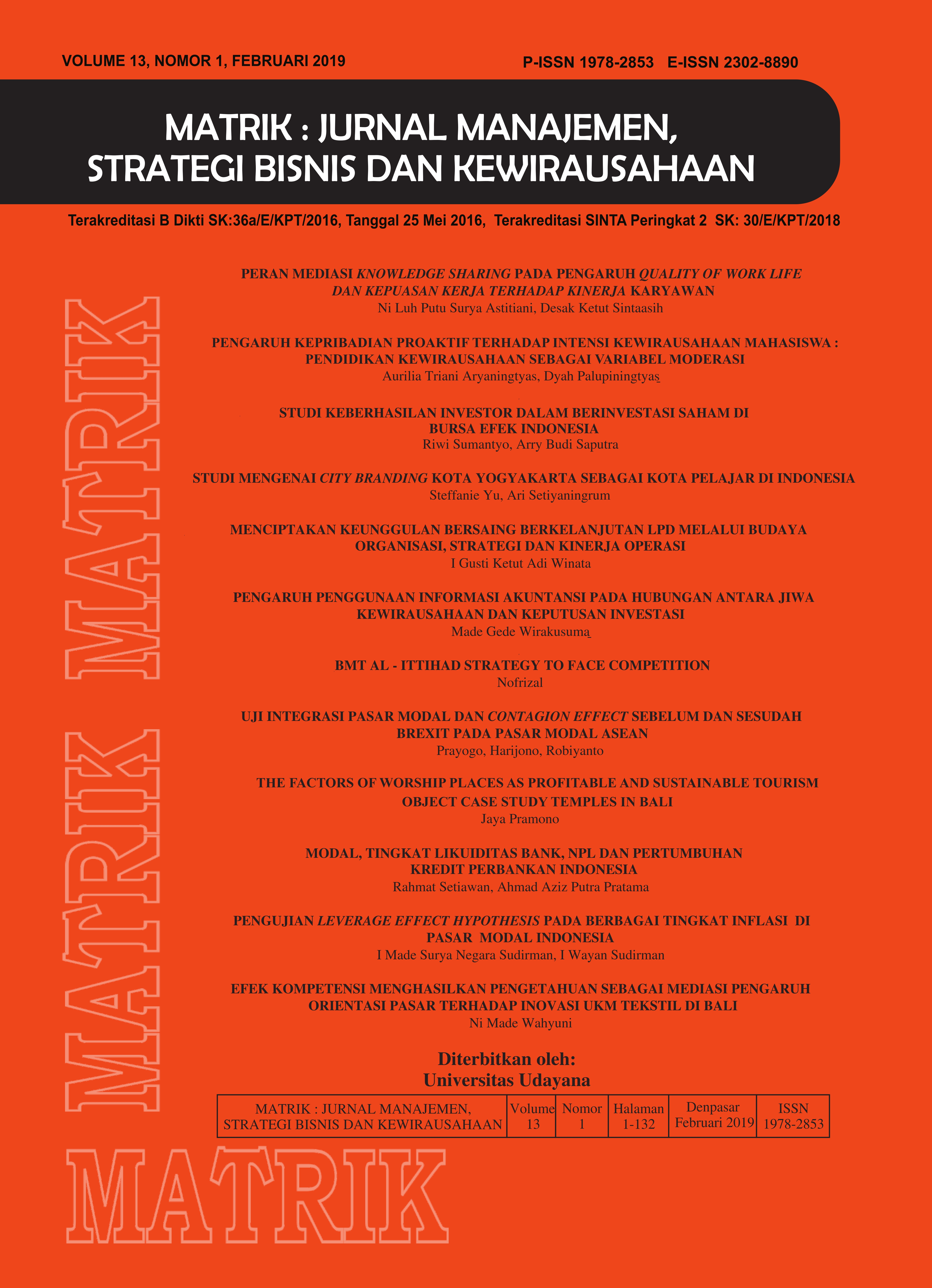UJI INTEGRASI PASAR MODAL DAN CONTAGION EFFECT SEBELUM DAN SESUDAH BREXIT PADA PASAR MODAL ASEAN
Abstract
This study examined capital market integration and contagion effect among ASEAN and UK capital markets. Data analysis will be divided to before the Brexit (January 2012 – 22 June 2016) and after the Brexit (24 June 2016 – December 2016). The analytical tool used is Vector Autoregressive (VAR) to analyze the integration between capital markets and Granger Causality to detect any contagion effect between capital markets. The conclusion of this research is existance of Brexit event can change the segmented ASEAN-5 region become more integrated. It’s found that the Singapore capital market is a capital market that recieves a contagion effect from the UK capital market before and after Brexit. As for the Indonesia, Malaysia, Philippines and Thailand’s capital markets only received contagion effects between regions, except Philippines capital market after Brexit does’t accept contagion effect from all countries.
Downloads
References
Craig, A., Dravid, A., & Richardson, M. (1995). Market Efficiency Around the Clock: Some Supporting Evidence Using Foreign Based Derivatives. Journal of Financial Economics, 39, 161-180. doi: https://doi.org/10.1016/0304-405X(94)00822-I
Daly, T. P. T. K. (2012). The Impacts of the Global Financial Crisis on Southeast Asian Equity Markets Integration. International Journal of Trade, Economics and Finance, 3(4), 299-304.
DBS. (2017). DBS Insights Retrieved February 20, 2018, from www.dbsinsights.com
FKMHII. (2016). Regionalisme: Fenomena “Brexit” Dampak bagi Inggris, Uni Eropa dan Dunia Retrieved February 21, 2018, from http://fkmhii.com/2016/11/12/regionalisme-fenomena-brexit-dampak-bagi-inggris-uni-eropa-dan-dunia/
G. Papavassiliou, V. (2014). Equity market integration: the new emerging economy of Montenegro. Review of Accounting and Finance, 13(3), 291-306. doi: 10.1108/raf-05-2013-0073
Ibrahim, M. H. (2006). International Linkage of ASEAN Stock Prices: An Analysis of Response Asymmetries. Applied Econometrics and International Development, 3(3), 191-202.
Karim, B. A., & Karim, Z. A. (2012). Integration of ASEAN-5 Stock Markets: A Revisit. Asian Academy of Management Journal of Accounting and Finance, 8(2), 21-41.
Kenani, J. M., Purnomo, J., & Maoni, F. (2013). The Impact of the Global Financial Crisis on the Integration of the Chinese and Indonesian Stock Markets. International Journal of Economics and Finance, 5(9), 69-81.
Liaw, K. T. (2004). Capital Market. Mason, Ohio: Thomson/South Western.
Mensi, W., Beljid, M., Boubaker, A., & Managi, S. (2013). Correlations and Volatility Spillovers Across Commodity and Stock Markets: Linking Energies, Food, and Gold. Economic Modelling, 32, 15-22. doi: 10.1016/j.econmod.2013.01.023
Muharam, H. (1999). Dampak Pelepasan Batas Kepemilikan Asing Terhadap Terintegrasinya Bursa Efek Jakarta dengan Bursa Efek Internasional (Studi Literatur). Jurnal Bisnis Strategi, 4(Desember).
Mulyadi, M. S. (2012). Analysis of Volatility Spillover in Indonesia, USA and Japan Capital Market. African Journal of Business Management, 6(27). doi: 10.5897/ajbm11.2054
Nainggolan, P. P. (2016). "Brexit": Penyebab dan Implikasi Globalnya Majalah Info Singkat: Kajian Singkat Terhadap Isu Aktual dan Strategis, 8(12).
Robiyanto, R. (2017a). The Analysis of Capital Market Integration in ASEAN Region by Using the OGARCH Approach. Jurnal Keuangan dan Perbankan 21(2), 169-175.
Robiyanto, R. (2017b). Performance evaluation and risk aversion rate for several stock indices in Indonesia Stock Exchange. Jurnal Manajemen dan Kewirausahaan, 19(1), 60-64. doi: 10.9744/jmk.19.1.60-64
Robiyanto, R. (2018). The dynamic correlation between ASEAN-5 stock markets and world oil prices. Jurnal Keuangan dan Perbankan, 22(2).
Robiyanto, R., Hersugondo, H., & Chotijah, G. S. (2016). ASEAN Economic Community (AEC) and Economic Stability: A Review from Indonesia's Side. International Journal of Economic Research, 13(2).
Robiyanto, R., Wahyudi, S., & Pangestuti, I. R. D. (2017a). Testing Commodities as Safe Haven and Hedging Instrument on ASEAN's Five Stock Markets Jurnal Ekonomi Kuantitatif Terapan, 10(2), 231-238. doi: https://doi.org/10.24843/JEKT.2017.v10.i02.p11
Robiyanto, R., Wahyudi, S., & Pangestuti, I. R. D. (2017b). The volatility–variability hypotheses testing and hedging effectiveness of precious metals for the Indonesian and Malaysian capital markets. Gadjah Mada International Journal of Business, 19(2), 167-192. doi: 10.22146/gamaijb.26260
Seth, N., & Sharma, A. K. (2015). International Stock Market Efficiency and Integration: Evidences from Asian and US Markets. Journal of Advances in Management Research, 12(2), 88-106. doi: 10.1108/JAMR-07-2011-0010
Soesastro, H. (2004). Kebijakan Persaingan, Daya Saing, Liberalisasi, Globalisasi, Regionalisme dan Semua Itu Economics Working Paper Series CSIS
Suganda, T. R., & Soetrisno, Y. (2016). Uji Integrasi dan Contagion Effect Pasar Modal Pada Lima Negara ASEAN (Riset Empiris Pasca Terjadinya Krisis Subprime Mortgage dan Krisis Yunani). Jurnal Keuangan dan Perbankan 20(2), 252-262.
Suryanta, B. (2011). Capital Market Integration in ASEAN Countries: Special Investigation of Indonesian Towards the Big Four. Asian Journal of Technology Management, 4(2), 109-114.
Tai, C.-S. (2007). Market Integration and Contagion: Evidence from Asian Emerging Stock and Foreign Exchange Markets. Emerging Markets Review, 8(4), 264-283
Valle, R. S. (1999). A Cointegration Analysis of Latin America Stock Markets and the U.S. SSRN Working Paper.
Volz, U. (2013). ASEAN Financial Integration in the Light of Recent European Experiences. Journal of Southeast Asian Economics, 30(2), 124-142.
Widarjono, A. (2016). Ekonometrika: Pengantar dan Aplikasinya. Yogyakarta: UPP STIM YKPN.
 This work is licensed under a Creative Commons Attribution-ShareAlike 4.0 International License.
This work is licensed under a Creative Commons Attribution-ShareAlike 4.0 International License.

















